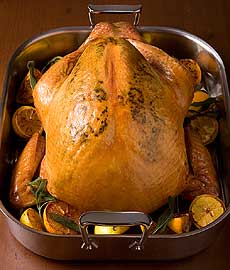How To Brine A Turkey
Page 1: The Extra Steps Yield Moister, More Tender Meat
This is Page 1 of a two-page article. Click on the links below to visit Page 2.
Introduction
It takes extra effort to brine a turkey—and two to 24 hours for the turkey to rest in the brine. But brining produces a moister, more tender turkey.
Brining a turkey is the process of soaking it, for an extended period of time, in a liquid that contains salt and other flavorings. The salt in a brine draws the natural moisture out of a turkey and allows it to be replaced with the moisture of the liquid in which you are soaking it. Therefore, whatever flavorings and seasonings you add to your brine will become infused in your turkey.
Brining a turkey helps to tenderize it, which not only improves the eating experience, but slightly cuts down on cooking time as well.
Brining Vs. Marinating
Brining is not to be confused with marinating
- While they have similar functions, a marinade’s key components are acid and salt.
- A brine in its simplest form can be nothing more than water, salt, and sugar. But we have much more interesting brine ideas below!
Part I: Steps To Brining A Turkey
First determine how much water you need by placing the turkey into an extra-large Ziplock-type bag. You can purchase a special turkey-brining bag locally or order one online. Even a trash bag can work if you seal it tightly.
- Place the bag in a large stockpot to keep the turkey upright.
- Add water one cup at a time, keeping track of how many cups it takes
to completely cover the turkey.
- Remove the turkey, toss out the water in the stockpot, and continue
creating the brine. (Green choice: Use the water on plants.)
Part II: Creating The Brine
Now we’ll create the mixture of water, salt, sugar and other flavors.
In a pot, add the amount of water you created in Part I.
Measuring The Salt. A key to a good brine is salt control. A general rule of thumb for measuring salt is one cup of salt to every gallon of water, which works out to roughly one tablespoon of salt to every cup of water. If you really want to be precise, you can weigh the salt and measure ten ounces per gallon of water.
Dissolving The Salt. It is important that the salt be completely dissolved into the water. The easiest way to do this is to use hot water and stir rapidly. Once the salt is dissolved, make sure to cool your water before brining, or you will actually begin to cook your turkey!
Adding The Sugar. It doesn’t hurt to add sugar to your brine; it will sweeten the meat a bit and balance out the salt. Add a cup of sugar for every gallon of water.
At this point—once the sugar is added—you have a very basic brine that will help to season your turkey and bring out its natural flavor. But don’t stop here!
Flavoring The Brine. You can add pretty much anything you want to season and flavor your brine (see the next section). Simply put the added seasonings, herbs and other flavors into your water-salt-sugar brine. and bring it to a boil, simmer for a few minutes, then cool completely and proceed as normal.
Continue To Page 2: Different Turkey Brines

| 



